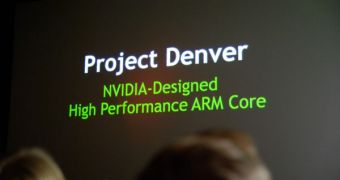Nvidia has recently announced, during a CES presentation, that it plans to build high-performance ARM-based processor cores, designed to support future products ranging from personal computers and servers to workstations and supercomputers.
Known under the internal codename of "Project Denver," this chip is designed to go after Intel and AMD, as Nvidia claims that it will “free PCs, workstations and servers from the hegemony and inefficiency of the x86 architecture,” in a blog post.
Although not many details are available at this time regarding the CPU's architecture, Project Dever will effectively embed dual or quad ARM cores inside a much larger pool of GPU vector hardware.
The move makes a lot of sense, considering that Microsoft has just announced that an ARM port of Windows 8 will be available once the OS is released.
Furthermore, present-day GPU solution have greatly surpassed CPUs in regards to floating point performance, highly parallel applications running far better on GPGPU solutions, such as Nvidia's own Tesla or AMD's FireStream.
The hard part, however, is to link the GPU with the embedded ARM cores allowing for the two parts to be run in an optimal way, similar to what Intel did for the Sandy Bridge architecture, but at a much greater scale.
"ARM's pervasiveness and open business model make it the perfect architecture for this new era.
With Project Denver, we are designing a high-performing ARM CPU core in combination with our massively parallel GPU cores to create a new class of processor," said Jen-Hsun Huang, president and chief executive officer of Nvidia.
If Nvidia succeeds in its endeavors, Project Denver could prove to be one of the major breakthroughs of the CPU world, changing the way we think about computing in the future.
Together with these plans, Nvidia has also announced that it licensed ARM's current Cortex-A15 processor for its future-generation Tegra mobile processors. (via Ars technica)

 14 DAY TRIAL //
14 DAY TRIAL //